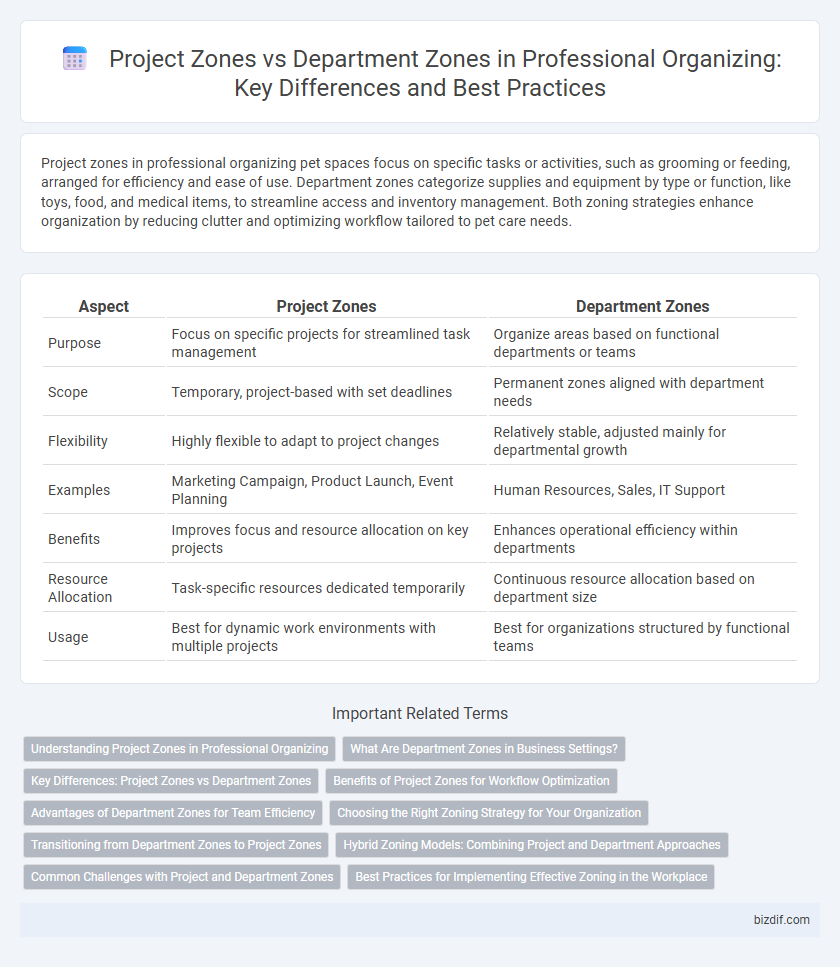Project zones in professional organizing pet spaces focus on specific tasks or activities, such as grooming or feeding, arranged for efficiency and ease of use. Department zones categorize supplies and equipment by type or function, like toys, food, and medical items, to streamline access and inventory management. Both zoning strategies enhance organization by reducing clutter and optimizing workflow tailored to pet care needs.
Table of Comparison
| Aspect | Project Zones | Department Zones |
|---|---|---|
| Purpose | Focus on specific projects for streamlined task management | Organize areas based on functional departments or teams |
| Scope | Temporary, project-based with set deadlines | Permanent zones aligned with department needs |
| Flexibility | Highly flexible to adapt to project changes | Relatively stable, adjusted mainly for departmental growth |
| Examples | Marketing Campaign, Product Launch, Event Planning | Human Resources, Sales, IT Support |
| Benefits | Improves focus and resource allocation on key projects | Enhances operational efficiency within departments |
| Resource Allocation | Task-specific resources dedicated temporarily | Continuous resource allocation based on department size |
| Usage | Best for dynamic work environments with multiple projects | Best for organizations structured by functional teams |
Understanding Project Zones in Professional Organizing
Project zones in professional organizing focus on grouping items and tasks based on specific projects or outcomes, enhancing efficiency by centralizing related materials. Unlike department zones, which organize spaces by functional areas or departments, project zones dynamically adjust to the stages and progress of a project, promoting clearer workflow management. This method optimizes resource allocation and ensures seamless collaboration, especially in complex or time-sensitive assignments.
What Are Department Zones in Business Settings?
Department zones in business settings refer to specific areas designated for different functional units such as marketing, finance, human resources, and operations. These zones are organized to streamline workflows, improve communication, and enhance productivity by grouping related tasks and personnel within the same physical or virtual space. Effective department zoning supports better resource allocation and fosters collaboration tailored to each department's unique objectives and processes.
Key Differences: Project Zones vs Department Zones
Project zones center around tasks and deliverables tied to specific projects, enabling dynamic organization and temporary resource allocation, while department zones focus on functional areas within an organization, structured to support ongoing operations and specialization. Project zones emphasize flexibility and collaboration across roles to meet deadlines, contrasting with department zones that prioritize consistent workflows, role clarity, and long-term resource management. Understanding these key differences aids in optimizing workspace design and workflow efficiency based on organizational needs.
Benefits of Project Zones for Workflow Optimization
Project zones streamline workflow optimization by creating dedicated spaces tailored to specific tasks, enhancing focus and reducing time wasted on locating materials. These zones improve collaboration among team members by aligning resources directly with project needs, fostering faster decision-making and execution. The flexibility of project zones allows seamless adjustments to shifting priorities, promoting efficiency and dynamic resource management.
Advantages of Department Zones for Team Efficiency
Department zones enhance team efficiency by grouping tasks and resources according to specialized functions, enabling clearer focus and reducing cross-functional confusion. This organizational method streamlines communication channels and accelerates decision-making within departments. Concentrated expertise in department zones leads to higher productivity and more effective use of skills and resources.
Choosing the Right Zoning Strategy for Your Organization
Project zones focus on organizing spaces based on specific tasks or initiatives, allowing for flexibility and adaptation as project needs evolve. Department zones group items and resources by functional areas, promoting efficiency through consistent layout and streamlined access for team members. Selecting the right zoning strategy depends on your organization's workflow dynamics, with project zones enhancing adaptability and department zones supporting specialized, ongoing operations.
Transitioning from Department Zones to Project Zones
Transitioning from department zones to project zones enhances flexibility by aligning workspace organization with specific projects rather than fixed departments, increasing efficiency and collaboration. Project zones prioritize dynamic resource allocation and cross-functional teamwork, reducing silos and streamlining task management. This shift supports agile workflows and accelerates project completion, optimizing professional organizing strategies for evolving business needs.
Hybrid Zoning Models: Combining Project and Department Approaches
Hybrid zoning models integrate project zones and department zones to optimize workspace efficiency and collaboration. Project zones cluster team members by specific tasks to enhance focus and agility, while department zones maintain functional groupings for resource sharing and expertise consolidation. This combined approach adapts dynamically to varying workflow demands, fostering both specialized project execution and cohesive departmental operations.
Common Challenges with Project and Department Zones
Project zones and department zones often face common challenges such as overlapping responsibilities and unclear boundaries, leading to inefficiencies and miscommunication. Maintaining consistent organization standards across diverse teams complicates workflow integration and resource allocation. Addressing these issues requires clear zone definitions and collaborative protocols to streamline operations and enhance productivity.
Best Practices for Implementing Effective Zoning in the Workplace
Project zones emphasize task-specific organization, grouping resources and workstations related to a single project for enhanced focus and collaboration. Department zones align spaces by functional roles, promoting departmental identity and streamlined communication within teams. Implementing effective zoning requires clear signage, ergonomic layouts, and adaptable boundaries to balance flexibility with structure, improving workflow efficiency and minimizing distractions.
Project zones vs Department zones Infographic

 bizdif.com
bizdif.com